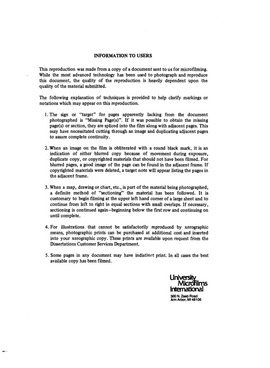| dc.contributor.author | Sunflower, Cherlyn, | en_US |
| dc.date.accessioned | 2013-08-16T12:29:00Z | |
| dc.date.available | 2013-08-16T12:29:00Z | |
| dc.date.issued | 1983 | en_US |
| dc.identifier.uri | https://hdl.handle.net/11244/5190 | |
| dc.description.abstract | The PeeC Method was found to be a reliable tool for acquiring information in quantifiable form about the student teachers' conceptual responses to educational events. Further reliability studies will be necessary to determine if similar results will be obtained when the PeeC Method is used by other raters using written comments from different student teachers or written comments from teachers currently in the field. Validity was preliminarily addressed by basing the PeeC dimensions and categories upon current literature on cognitive development. Construct and concurrent validity studies will be necessary to further validate the PeeC Method as a means for quantifying student teachers' conceptual responses to educational events. Once these studies are successfully completed, data collected using the PeeC Method may enable teacher educators and supervisors to document student teachers' and teachers' conceptual growth and tailor interventions to their stages of cognitive development, amount of experience, and degree of maturity. | en_US |
| dc.description.abstract | An objective and quantifiable method for collecting information on student teachers' conceptual responses to educational events was developed and initial steps were taken to establish validity and reliability. It was named the PeeC Method. Through a review of the literature on congnitive development, four constructs were identified: how many elements a student teacher perceived and/or recalled about an educational event; what kinds of elements in an educational event were perceived; whether the student teacher merely reported his/her perceptions or if meaningful relationships were constructed; and who or what was designated as responsible for what occurred. These constructs served as the basis for the dimensions of the PeeC Method: Thought Unit, Source, Type of Thought, and Attribution. | en_US |
| dc.description.abstract | The development of the PeeC Method involved the collection of student teachers' written comments about educational events and a three phase content analysis procedure for testing the categories within the four PeeC dimensions. An analysis of the data indicated that the dimension categories, category definitions, and category examples within each PeeC dimension were reliable as evidenced by the investigator's ability to classify written comments across two time periods with over 80% consistency; exhaustive as evidenced by raters' ability to classify all written comments of student teachers; and reliable as well as mutually exclusive such that two different groups of three raters achieved over 80% agreement when classifying written comments. | en_US |
| dc.format.extent | ix, 201 leaves ; | en_US |
| dc.subject | Education, Teacher Training. | en_US |
| dc.title | A method for classifying student teachers' conceptual responses to educational events / | en_US |
| dc.type | Thesis | en_US |
| dc.thesis.degree | Ph.D. | en_US |
| dc.thesis.degreeDiscipline | Jeannine Rainbolt College of Education | en_US |
| dc.note | Source: Dissertation Abstracts International, Volume: 44-11, Section: A, page: 3361. | en_US |
| ou.identifier | (UMI)AAI8404558 | en_US |
| ou.group | Jeannine Rainbolt College of Education | |
